|
SYNOPSIS & INTRODUCTION (During 2004 – 5, a group of Alexander residents worked on a Comprehensive Plan for the town. Below is the history chapter of that plan. Details of the activities and people of Alexander and the area can be found in the 125 issues of the historical society’s newsletter. Click here to see the index. ************************************************* INTRODUCTION:
This place we call Alexander was first delineated in 1786 as
NATIVE AMERICANS & EARLY SETTLEMENT:
Undoubtedly, Native Americans traveled through
and seasonally resided in this place we now call Alexander. They would
have used the waters of the East Machias, Dennys and St. Croix watersheds,
not only as transportation routes, but also as sources for food. Artifacts
have been surface collected from around the lakes and streams, but no
habitation site has been found. The first known Euro-American settler
was Samuel Brown who settled with his family at the north edge of town
before 1810. If he and the census taker had known where the line was
between townships 16 and 17 (Alexander and Princeton), records would prove
that our population was 7 in 1810. By 1820 we had 114 people living within
our bounds. These twenty families were descendants of the English who had
migrated to America in the first half of the seventeenth century. Our
first settlers’ ancestors had migrated up the coast from Massachusetts and
New Hampshire over a period of 150 years. During that first decade of our history,
at least five families settled here and left. This great mobility of the
American people would continue to be a factor in the make-up of
Annaniah Bohanon told a reporter for the Calais Advertiser in 1870 that the first settlers were William Connick and Solomon Perkins who came in 1810. William Crockett, Elias Spring and Bohanon followed the next year. Sam Cottle’s wife was the first woman in town, and the first death was of Mrs. Mary Young who died on April 18, 1814. She was Annaniah’s sister-in-law. Freeman Putnam Fenlason, born June 4, 1812, was the first white child born here. GOVERNMENT & EARLY DEVELOPMENT: Alexander was an unorganized township until immediately after statehood. For election purposes, Alexander was made Plantation #16 by the Legislature in 1820. Several years later the residents petitioned for Plantation #16 to become an incorporated town. The name Alexander was chosen, after Alexander Baring. Alexander was Maine’s 258th town and Baring the 259th town, both incorporated on January 19, 1825. Both were incorporated towns, having all the powers, privileges, and immunities enjoyed by unchartered towns.
Growth was from 114 residents in 1820 to 544 people in 1850, the greatest population ever. Most came looking for a better life. Land for farming and timber for harvesting, along with a proprietor who cared for the settlers, drew people here. Our rocky soil and cool climate, plus the promise of better land elsewhere caused some to leave. Settlers came to Alexander from several areas. Forty-six came from Southwestern New Brunswick (St. Stephen to St. John) and twenty-eight came from Calais. Machias and East Machias sent seventeen settlers our way. Nine families came from Ireland and sixteen from Massachusetts and New Hampshire. Naturally, some came to Alexander from our neighboring towns. Out-migration was prompted by the California gold rush, Civil War, depletion of the marketable white pine, the development of the mills in Woodland, and by the lure of a better life off the farm. Alexander’s population dropped steadily after 1850 until in 1970 we had but 169 residents. EDUCATION: The first schoolhouses were built in 1822. They were log buildings, one on the Airline in the western part of town, and the other on Burnt Barn Hill, one half mile west of the Cooper Road on the way to Breakneck Mountain. Starting near the middle of the
nineteenth century, frame one room schoolhouses were The teachers were usually women during the summer terms and men in the winter when boys likely were in attendance. Women teachers often were products of the one room school, whereas men teachers often had a year or two at an academy (like Calais or Washington), and, in the past century, some men trained at the Normal School in Machias. Teachers often boarded at nearby homes. It is interesting to note that three of the six district schools were in neighborhoods now abandoned. The last one-room schoolhouses to close were Districts #1 and #2 in June 1957 when a consolidated schoolhouse was opened at the corner of the Arm and Cooper Roads. Children from Cooper also went to that school during some of its thirty-year history.
The members of The Church of the Open Bible opened Downeast Christian School in the fall of 1977. It was the first Christian school in Washington County. The school, located beside the church building on the Airline, continues to educate children from this area with a small professional staff and volunteers. ORGANIZED RELIGION: The first preacher was Mr. Foss, a Free Will Baptist, who arrived in 1816. Others followed, traveling from town to town. One circuit in 1841 comprised of Cooper, Alexander, Crawford, Princeton, Wesley, and Northfield.
During the mid-1930s, Pentecostal tent meetings were held at Morey Hunnewell's on Route Nine. As a result of religious interest developed at these meetings, a group decided to build a church. Volunteer workers on land donated by Allen and Arlene Strout put up the structure. The first service was on October 25, 1939. Cliff McCarty was the first pastor. The last services were held about 1965. Starting in 1949 Sunday school was held in Cedar School on Gooch Hill. Ruth Dwelley served as teacher and superintendent. Cedar Sunday School was incorporated in 1957 and in 1958 became Cedar Chapel. The last session of the Sunday school was in 1967 and in August 1968 the group ceased to work and later the building and land was sold. About 1950 a group of Conservative Baptist ministers and some local area people created the Kadish Bible Kamp to benefit the young people of the area churches. A camp was built on Round Pond in Charlotte and another here on Barrows Lake. Both properties were eventually sold, the Barrows Lake camp to Carleton Davis. In June 1976 plans were made to
establish The Church of the Open Bible with Richard Fowler as pastor.
Services were held at the Grange Hall and prayer meetings at individual
homes. The first service held in the new building on the Airline was in
the fall of 1976. Robert Chamberland was the pastor here for several years
until recently. PRIMARY INDUSTRY: FARMS
& FORESTS: According to
the Calais Advertiser of September 6, 1860 as quoted by Harold Davis in
An International Community on the St. Croix, “… Crawford, Cooper,
Baileyville and Alexander were towns where farming took up four months,
logging took up four months, and loafing around … the remainder of the
year. The towns were
FARMS: This statement was true of all interior Washington County, and even Hancock County. The land was and still is rocky. Farming in most of the nineteenth century did not produce much, if any cash income. However, farming was central to the livelihood of Alexander people from the first settler until after World War Two. In reality, the early farm family produced food for the table, fiber for clothing, fuel for cooking and heating, and lumber for structures to house the family and their animals. These farms were subsistence farms. The invention about 1880 of the separator brought about a change in farming. Farmers purchased dairy cows then separated the milk into cream and skim milk. The skim milk was used to feed hogs, which became food for the family or were turned into cash. The cream went to the International Creamery collection building on the Cooper Road. Their plant in Calais turned cream into butter which was shipped to the big cities along the East Coast. Farmers increased the size of their flocks of sheep. Until this time (1880), only sheep enough for meat and wool for the family were kept. Now in Calais, Pembroke and other towns, carding machine owners sent wool buyers around the country-side paying cash for wool. Improvements in apple genetics allowed farmers to plant orchards, and ship barrels of the apples to the cities. Before 1880, most apples grown here were used for vinegar, cider, and animal food. Many orchards were destroyed in May 1935 when a major freeze killed many trees and this source of income. As a result of this farm prosperity, farm families formed Alexander Grange, Patrons of Husbandry in 1889. The Grange Hall was built in 1908. Another result of this economic activity was the incorporation of the Alexander Farmers’ Union formed on March 30, 1918. It was to help its 33 members buy supplies and market their products. When the mills were built in Woodland, and its population grew, a market for farm products was opened to Alexander farmers. Butter, eggs, cream, root crops, apples, and fresh berries were taken by wagon or pung to customers, some of whom had moved from Alexander for a cash-paying job in the mills. Some farmers started peddling in Calais and soon found markets. By the late 1940s Bert Varnum saw an opportunity to sell large quantities of milk in Calais and Woodland and built a pasteurization plant at his farm on the Airline. He purchased raw milk from local producers. When Grant’s Dairy of Bangor purchased Bert’s operation, it signaled the end of food production for local markets as an industry in Alexander. Abandoned pastures and hayfields soon grew up with miscellaneous plants including blueberries. Canning blueberries had started at the time of the Civil War and the arrival of the railroad in 1898 in Washington County provided a way to get fresh and processed berries to markets. As we enter the twenty-first century, blueberries are the only commercial farm crop in Alexander. The economic value of these blueberry producing fields give Alexander its wonderful open areas and scenic views. FORESTS: The forests that surrounded the farms provided cash income for the residents. For the first forty years or so, the men would spend the winter here in Alexander cutting pines and moving the logs to the waterways for driving to the mills in spring. By the Civil War, pine were about gone from our town and the men had to go up the St. Croix or up the Machias to work in logging crews on those watersheds. Some also took part in the river drives. By 1880 men turned to logging spruce along the same watersheds, and to working in the bark woods. We had no tannery, but our men had work because of tanneries at Princeton, Grand Lake Stream, Jackson Brook, and Beddington. Several Alexander men went to the West Coast to log, Robert Clark Brown stayed for seventeen years. Working in the woods did pay cash and the economy was changing from barter to cash. Cash also could buy a ticket out of here, to the pinewoods of the Middle West where the farms were free of rocks. Early sawmills provided for the local market; Stephenson’s Mill, later Dwelley’s, on Sixteenth Stream and Cheney’s mill on Pocomoonshine were such mills. A man named Burns had a brickyard near Pleasant Lake for the local market. From 1935 to 1946 Stowell-MacGregor had a spool bar mill at the end of the Pokey Road. This employed local men in the woods as well as at the mill. Starting in 1947. Ernest LaBelle had a portable sawmill in several locations in the area. His was a family operation, so hired fewer local men. During the first half of the twentieth century farmers cut and sold firewood in Woodland and Calais, and cut pulpwood for St. Croix Paper Company in Woodland. Some supplemented their income cutting and shaving hoops and bounty hunting for porcupines. Many families also ate venison year-around. Today families supplement their income by working in the blueberry harvest or in the Christmas greenery business. Crawford Evergreens, owned by Randy and Susan Wallace from 1993 to 2003, employed men gathering boughs, and men and women making wreaths, Today the business is owned by David Whitney of Machias. Much of the forestland in Alexander still produces fir tips, logs, fuel, and fiber for local and area needs. Most of the harvest is now mechanical. Some local people are employed in harvesting and transporting these products, some in industry using them, and some landowners supplement their income by selling them. HISTORIC STRUCTURES & LAND USE:
With few exceptions, all the structures built in
Alexander during the nineteenth century were related to the farm;
Lewis Adams built the first summer home
on Pocomoonshine Lake in 1908. It wasn’t until after WWII that camps
suddenly became popular and affordable. Many children and grandchildren of
Alexander people who were living in Calais or Woodland built camps on
Pleasant Lake.
Summer home construction got started on Barrows Lake, Meddybemps Lake (Berry Road) and Pocomoonshine Lake (Pine Tree Shore) about 1970. Meddybemps Shores access was put in during the late 90s and soon after summer and year-around homes were being constructed. Another major change came in the mid-1970s when owners started converting summer camps into year-round homes. Land in Alexander was classified as settled land and wild-land. The settled land was owned and farmed by local residents. This land included the woodlot, meadow, pasture, hayfields, cropland, and finally the area around the buildings, i.e. the dooryard and the barnyard. Not all had a meadow, but all required the other types of land to survive. This land division existed until after WWII. Wild-land, large blocks of forested-land generally belonged to out of town individuals and/or corporations, a situation that continues to this day. This land has always been used to produce forest products to provide income for the landowners. Much of the lakeshore development has occurred on what once was wild-land. TOURISM:
Lewis Adams came here in 1908 to rusticate and fish. Herb Dudley
SELECTED TIMELINE 1774 Alexander Baring was born in England. 1786 Township 16 (now Alexander) delineated in Massachusetts Land Lottery map. 1796 Alexander Baring toured Hancock and Washington Counties prior to investing. 1808 Benjamin R. Jones surveyed Township 16 and made a revised map with 128 lots. 1810 Census records indicate Sam Brown’s family only residents of Township 16. 1813 First settlement of Breakneck Mountain was made by four families from Machias. 1816 Stephenson’s sawmill built on 16th Stream at the foot of Pleasant Lake 1820 Stephenson added a gristmill so corn and wheat could be ground into flour. 1822 First schools opened. 1832 Jesse Stephenson appointed first post master in Alexander. 1840 Ninety-six homes existed, a number not to be exceeded until the late 20th century. 1841 John Taylor died, he was our first town clerk 1848 Manly B. Townsend died, was President of the Maine Senate. 1850 Population reached 544, greatest ever. 1852 Three men died in well on Breakneck. 1857 Airline Stage Company established with a stop at Ben Strouts. 1861 Civil War started and forty-six Alexander men went to war, at least five never returned. 1863 State Aid to wives and dependant children of soldiers was started. 1869 M-E Church dedicated. 1887 Airline Stage ceased operation. 1889 Belcher Tyler died, he represented Alexander in the Maine House. 1893 Powers of school districts transferred to the town school committee. 1902 Cedar School built. 1908 Lewis Adams built the first summer home. (Pocomoonshine Lake) 1908 The Grange Hall is dedicated. It stands on a locally quarried granite foundation. 1918 Alexander Farmers Union started. 1922 First Annual Report printed and distributed to citizens. 1938 Ted and Elza Junimann moved to Breakneck. Were they German spies? 1947 Elbridge McArthur became one of the first to commute to work from Alexander. 1957 Consolidated school at corner Arm and Cooper Roads opened. 1961 Ski slope opened on Breakneck Mountain. 1970 Alexander reached low point in population, 169 residents. 1976 Selectmen authorize History of Alexander by Ruth Dwelley 1980 First issue of Alexander-Crawford Historical Society Newsletter published. 1987 Alexander Elementary School welcomed scholars. 1990 Manly Townsend house burned on town meeting day. 1993 Crawford Evergreen opened in Alexander 1994 Municipal building dedicated for fire department and town office. 1995 Airline completely rebuilt (started in 1989) all through town. 2003 Sand salt shed completed. 2005 Alexander plans for the future.
ALEXANDER TODAY HISTORIC BUILDINGS & SITES: Early settlers usually built a log home with a dirt floor and a hole in the roof to let out the smoke. None of these primitive structures exist today. Settlers’ permanent homes were built as soon as possible thereafter. There were post and beam frame houses. Being on the frontier, these homes were built by the owners who were farmers and loggers, not carpenters. Of those capes built before the Civil War, only seven still stand. They are at 898 Airline Road where Gary Howland lives, 1516 Airline Road where Pliney Frost lived, 1886 Airline Road where Zela Cousins lived, at 102 Tommy Long Road where Merle and Ruth Knowles live, at 179 Cooper Road where Irene McKain lives, at 311 Arm Road where Rose Williams lives, and at 3 Dwelleys Lake Road where Lew Dwelley lives. Many of these home have had major structural changes. Starting at the time of the Civil War, homes were built with the gable end toward the road and with the front door also facing the road. Homes built during this time include 1288 Airline Road owned by Fred Wallace, 1049 Airline Road where Joe Wallace lives, 87 Spearin Road where David McVicar lives, 89 Arm Road where Carroll Niles lives, 589 Cooper Road where Barbara McArthur lives, and 731 Cooper Road, the Lincoln Flood place, also known as the Pottle Place. Three other buildings were built during the 40 years after the Civil War. 151 South Princeton Road is a small cape that is home to Keith Prout. 1437 Airline Road was built after the original home burned in 1898; David Frost lives here now. 260 Spearin Road was a small cape built just after the War and occupied today by Richard Smith. 580 Cooper Road was built in 1902 as a schoolhouse for District 4; it now is Norman and Donna Brown’s home. Several barns are over 100 years old including Nelson Flood’s and Clinton Flood’s. Hale School, which belongs to Roger Holst, is over 150 years old. The Grange Hall (1908) is the oldest public accessible building in town. CEMETERIES:
The town cemetery is located north of the Airline on what
was
There are a number of family burial plots about town representing the following families; Bohanon, Brown, Davis, Flood, Frost, Perkins, and Stephenson. The only family plot that is well maintained is the Flood plot on the Cooper Road. Numerous other family plots exist, but have not been located. ARCHAEOLOGICAL SITES: The Maine Historic Preservation Commission has done no surveys for prehistoric archaeological sites in Alexander. No prehistoric archaeological sites are known in Alexander although the potential exists for these sites along the shores of the lakes and streams. MHPC has surveyed along the Airline relative to its reconstruction. Members of the Alexander – Crawford Historical Society have located 41 historic archaeological sites have been located using GPS. It is estimated that at least this many more sites are out there. These sites mostly represent building foundations, wells, burial sites and even a gold mine. THREATS TO EXISTING SITES: The greatest threat to historic buildings and archaeological sites in the lack of knowledge among landowners. Many old buildings have been intentionally destroyed without measurements and photographs. Many cellars and wells are filled and leveled without first creating a GPS record. A-CHS published “Century Homes of Alexander” in 1998. Of the eighteen homes, one was taken down by its owner, one completely renovated, and one thoughtfully restored. SELECTED REFERENCES: Information for this history of Alexander came from back issues of the Alexander-Crawford Historical Society Newsletter and from A-CHS files. Other sources included Selectmen’s Ledger 1847-1900, Assessors’ book 1875-1899, Annual Reports 1923-2004, and History of Alexander by Ruth Dwelley. SUMMARY: The history of Alexander is based upon the natural resources that drove the local and regional economy, including logging, and more recently, blueberries. Many current residents can trace their families back to the town’s early days. Alexander enjoys many of the benefits from our past. It is a small town with a strong sense of community where people look out for one another. While encouraging new development, the town seeks to maintain a link to its heritage and support for development that retain the scale and appearance of the town as well as preserve its historic character.
|
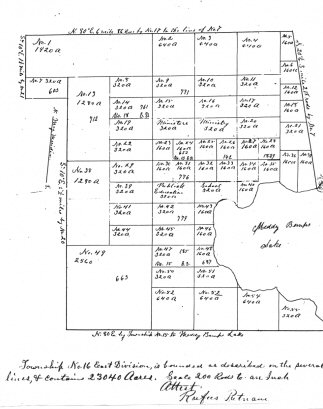 Township 16
on a map/plan created by Rufus Putnam. This plan, created for the
Massachusetts Land Lottery, divided the township into 55 lots. Ownership
of the Township, excepting those twelve lots won in the lottery, passed
through several owners until, in 1793, virtually the entire area between
the St. Croix River and the Penobscot River was purchased by William
Bingham of Philadelphia. Bingham had financial problems, and in 1797, sold
part interest of this land to Baring Brothers Bank of London, England.
Alexander Baring of that bank later became Bingham’s son-in-law, and this
town bears his given name.
Township 16
on a map/plan created by Rufus Putnam. This plan, created for the
Massachusetts Land Lottery, divided the township into 55 lots. Ownership
of the Township, excepting those twelve lots won in the lottery, passed
through several owners until, in 1793, virtually the entire area between
the St. Croix River and the Penobscot River was purchased by William
Bingham of Philadelphia. Bingham had financial problems, and in 1797, sold
part interest of this land to Baring Brothers Bank of London, England.
Alexander Baring of that bank later became Bingham’s son-in-law, and this
town bears his given name. 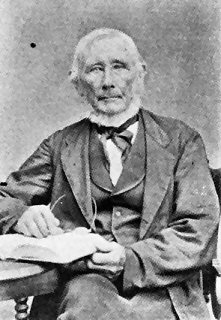 our
population. This mobility explains why cemeteries in Wisconsin have the
same family names as ours, and why this town was once home for families
now living clear across the country.
our
population. This mobility explains why cemeteries in Wisconsin have the
same family names as ours, and why this town was once home for families
now living clear across the country. built in the six
districts. District 1 was at the Four Corners, #2 was Hale school and
still stands on the Cooper Road, #3 was on Robb Hill and a joint venture
with Baileyville. District #4 became Cedar School early in the twentieth
century, District #5 was on Breakneck Mountain, and #6 was at Sears Corner
on the Crawford Road. These schoolhouses were within walking distance of
the pupils. During this time, children living near Princeton, Cooper, or
Crawford often attended schools in those towns with Alexander paying
tuition.
built in the six
districts. District 1 was at the Four Corners, #2 was Hale school and
still stands on the Cooper Road, #3 was on Robb Hill and a joint venture
with Baileyville. District #4 became Cedar School early in the twentieth
century, District #5 was on Breakneck Mountain, and #6 was at Sears Corner
on the Crawford Road. These schoolhouses were within walking distance of
the pupils. During this time, children living near Princeton, Cooper, or
Crawford often attended schools in those towns with Alexander paying
tuition. 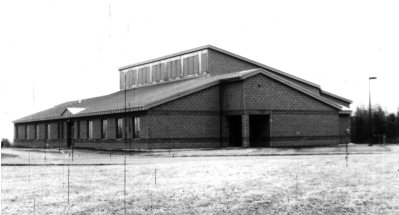 In the spring of 1987, children moved
into Alexander Elementary School. This five-classroom building also has a
large multipurpose room. On July 13, 1987 a special town meeting was held
in that room to allow the town’s people to discuss their views on use of
the old schoolhouse. The library addition was completed and the scholars
moved in on March 5, 1993.
In the spring of 1987, children moved
into Alexander Elementary School. This five-classroom building also has a
large multipurpose room. On July 13, 1987 a special town meeting was held
in that room to allow the town’s people to discuss their views on use of
the old schoolhouse. The library addition was completed and the scholars
moved in on March 5, 1993.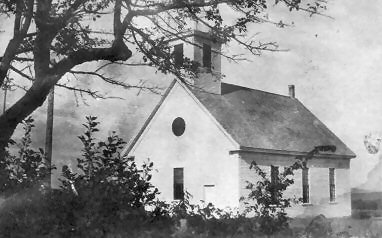 Construction of the Methodist–Episcopal
Church was started in 1866 and the building was dedicated in 1869. This
was on the Cooper Road; just north of where the Grange Hall now stands.
This Church was very active until 1905 when a group that included former
Alexander residents started the Peoples Methodist Church in Woodland.
After that the local Church operated using the minister from Woodland and
usually on a seasonal basis. It ceased operation in the mid-1960s and was
sold and demolished in 1975. Three factors contributed to the demise of
this church; lower population, the automobile, and less interest in
attending church services.
Construction of the Methodist–Episcopal
Church was started in 1866 and the building was dedicated in 1869. This
was on the Cooper Road; just north of where the Grange Hall now stands.
This Church was very active until 1905 when a group that included former
Alexander residents started the Peoples Methodist Church in Woodland.
After that the local Church operated using the minister from Woodland and
usually on a seasonal basis. It ceased operation in the mid-1960s and was
sold and demolished in 1975. Three factors contributed to the demise of
this church; lower population, the automobile, and less interest in
attending church services.
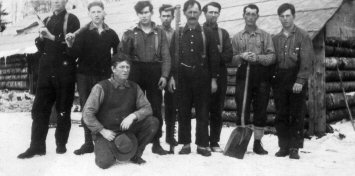 cursed with enough timber to destroy thrifty farming,
yet not enough to make prosperous lumbering. Young men grew up with an axe
and pick pole in hand, and after trying the sociability of working in
large crews, or on the rivers driving logs had no relish for picking up
stones alone on a ten acre lot….”
cursed with enough timber to destroy thrifty farming,
yet not enough to make prosperous lumbering. Young men grew up with an axe
and pick pole in hand, and after trying the sociability of working in
large crews, or on the rivers driving logs had no relish for picking up
stones alone on a ten acre lot….”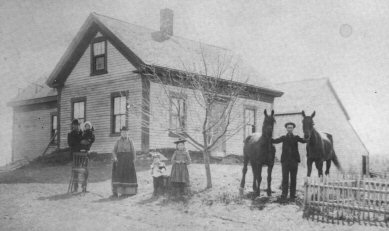 the
single family home that might house three generations of the one family,
the barn(s), and other outbuildings necessary for farming. The exceptions
were the schoolhouses, the Church, the dam on Sixteenth Stream, logging
camps, and the few small mills.
the
single family home that might house three generations of the one family,
the barn(s), and other outbuildings necessary for farming. The exceptions
were the schoolhouses, the Church, the dam on Sixteenth Stream, logging
camps, and the few small mills. 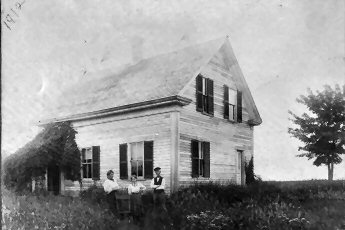
 built a
moose hunting camp here in 1910. Hunting, fishing, and rusticating have
been the prime tourism activities for the past century. Recently snowmobiling and four-wheeling have become enjoyable activities, primarily
because of the trail system developed by Breakneck Mountain Snowmobile
Club and its trail master Charlie White. Carleton Davis started a ski
slope on the north side of Breakneck Mountain which was not successful,
however, the camp ground he created on the shore of Pleasant Lake has
drawn tourists, many Canadian, to Alexander since the mid 60s.
built a
moose hunting camp here in 1910. Hunting, fishing, and rusticating have
been the prime tourism activities for the past century. Recently snowmobiling and four-wheeling have become enjoyable activities, primarily
because of the trail system developed by Breakneck Mountain Snowmobile
Club and its trail master Charlie White. Carleton Davis started a ski
slope on the north side of Breakneck Mountain which was not successful,
however, the camp ground he created on the shore of Pleasant Lake has
drawn tourists, many Canadian, to Alexander since the mid 60s.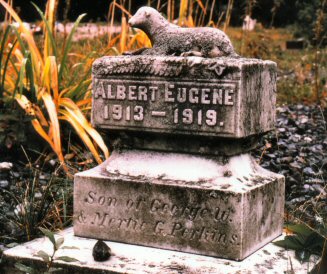 known as Sand Hill. Stone inscriptions indicate it has been in
use since 1830. In 1856 the town voted $70.00 to fence the Sand Hill
cemetery, and in 1878 the town purchased the property with a payment of
$4.00. In recent years scholars from Alexander Elementary School have
placed flags on veterans’ graves, an exercise that connects them to the
past and to the important role that veterans play in our country.
known as Sand Hill. Stone inscriptions indicate it has been in
use since 1830. In 1856 the town voted $70.00 to fence the Sand Hill
cemetery, and in 1878 the town purchased the property with a payment of
$4.00. In recent years scholars from Alexander Elementary School have
placed flags on veterans’ graves, an exercise that connects them to the
past and to the important role that veterans play in our country.